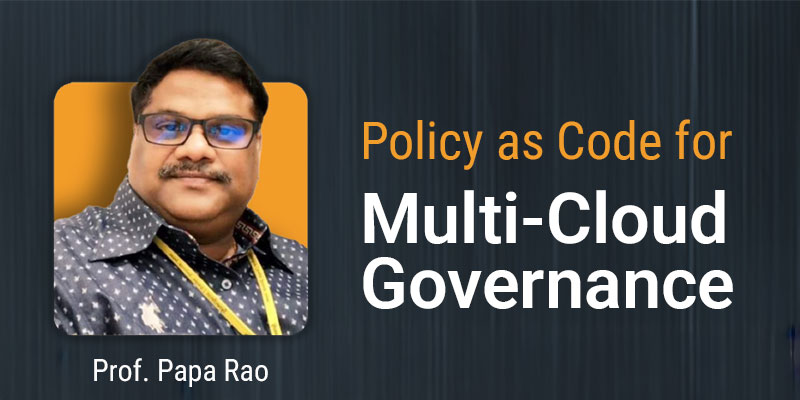Policy As Code For Multi-Cloud Governance

Managing AWS, Azure, GCP, and private cloud environments simultaneously is no small feat. Different interfaces, scattered logs, inconsistent security policies, and evolving regulatory requirements can turn multi-cloud governance into a time-consuming puzzle.
REVA Academy for Corporate Excellence tackled this head-on with their insightful webinar, “Policy as Code for Multi-Cloud Governance”, led by Papa Rao, a seasoned corporate trainer with over 26 years of experience in cloud technologies, DevSecOps, MLOps, and enterprise architecture.
The session didn’t just highlight challenges—it offered actionable solutions.
For working professionals navigating the multi-cloud era, this webinar served as a roadmap to smart, scalable, and automated cloud governance—showing that the key to mastering multi-cloud isn’t working harder; it’s governing smarter. This is exactly the kind of knowledge you gain in a Masters in Cloud Computing, where multi-cloud strategy and policy-as-code practices are core learning modules.
The Growing Complexity of Multi-Cloud Environments
Papa Rao began by highlighting the challenges organizations face while managing governance in multi-cloud environments. With different cloud providers offering distinct native tools, maintaining consistent compliance across AWS, Azure, GCP, and private clouds becomes complex.
According to the Flexera 2024 State of the Cloud Report, 89% of organizations now employ multi-cloud strategies, reflecting a modest yet significant increase from the previous year.
This complexity often leads to fragmented governance, increased risk of non-compliance, and challenges in cost optimization. Professionals pursuing a cloud computing masters degree are trained to handle such real-world multi-cloud challenges, making them highly employable.
Multi-Cloud Security Challenges and Policy as Code Solutions
Managing multi-cloud environments introduces unique security and governance challenges. During the webinar, Papa Rao also highlighted key challenges organizations face and how policy as code (PaC) can address them effectively:
| Challenge Category | Description of Challenge | PaC Solution(s) |
|---|---|---|
| Fragmented Visibility & Control | Each cloud provider has unique tools, logs, and interfaces, making a unified security view difficult. | Centralized Policy Definition: Policies defined in a single, common language and stored in a central repository for unified management. |
| Inconsistent Policies & Controls | Security configurations vary widely between providers, leading to gaps or conflicting standards. | Standardized Configurations: Policies enforce consistent settings across all cloud environments, reducing inconsistencies. |
| Misconfigurations & Human Error | Lack of standardization increases the likelihood of errors like overly permissive access or misconfigured storage. | Automated Enforcement & Drift Correction: Policies automatically validate configurations and correct deviations, minimizing human error.
|
| Expanded Attack Surface | More endpoints, APIs, and resources in multi-cloud increase potential entry points for attackers. | Shift-Left Security: Integrates security checks early in CI/CD pipelines to detect and fix vulnerabilities before deployment. |
| Compliance Complexity | Varying regulations across multiple jurisdictions require detailed audit trails and centralized reporting, often unavailable out-of-the-box. | Continuous Monitoring & Auditability: Provides real-time compliance status and auditable records, simplifying regulatory adherence. |
| Skills Gap & Resource Constraints | Shortage of personnel with expertise in vendor-specific security tools and limited budget for comprehensive security. | Enhanced Collaboration & Testable Policies: Common language and automated testing reduce reliance on specialized manual effort and foster shared responsibility. |
| Data Integration & Consistency | Inconsistencies and latency issues can compromise data integrity when synchronizing across platforms. | Unified IAM: Centralizes identity management across clouds, ensuring consistent access controls and reducing data exposure risks. |
| Integration Difficulties | Incompatible services/APIs between cloud platforms can create security gaps. | Standardized Configurations & Automated Deployment: Ensures consistent application of rules despite underlying platform differences. |
Policy as Code Demystified: Governance That Moves at the Speed of DevOps
During the webinar, Papa Rao explained that policy as code integrates seamlessly into the CI/CD pipeline, allowing organizations to implement governance before production deployments—a principle known as “shifting left”. Instead of waiting to discover non-compliant resources after deployment, developers and operations teams can validate infrastructure and application code early in the development lifecycle. This approach reduces risks, improves efficiency, and ensures compliance from the start.
He emphasized the key benefits of policy as code: consistency, ensuring that policies are applied uniformly across all environments; automation, reducing manual interventions; scalability, enabling large enterprises to manage thousands of resources; and real-time monitoring, which detects configuration drifts and triggers alerts or automatic remediation. These principles are also integrated into REVA Academy for Corporate Excellence Masters in Cloud Architecture & Security, where participants learn to apply policy as code across multi-cloud environments.
Your Policy Toolkit: The Best Code-Driven Solutions for Multi-Cloud Mastery
Papa Rao provided an extensive overview of the tools available for implementing policy as code. While cloud-native tools like AWS Config, Azure Policy, and GCP Organization Policies exist, organizations often prefer unified, vendor-agnostic solutions to manage policies across multiple clouds. The primary tools discussed were:
| Tool | Key Features | Use Case |
|---|---|---|
| Open Policy Agent (OPA) | Open Policy Agent (OPA) Open-source, uses Rego DSL, integrates with Kubernetes and other cloud-native environments | Enforcing compliance in containerized and cloud-native setups |
| HashiCorp Sentinel | Policy as code framework integrated with Terraform, HCL based | Ensuring Terraform-managed infrastructure adheres to corporate policies |
| Cloud Custodian | Python-based, supports AWS, Azure, GCP, OCI, and more; policies defined via YAML/JSON | Automated resource management, tagging, deletion, and governance
|
| Pulumi CrossGuard | Policy enforcement framework within Pulumi for multiple clouds | Multi-cloud governance with infrastructure-as-code (IaC) workflows |
| Confest | Uses Rego policies for structured configuration validation | Validating infrastructure and application configurations across environments |
| Pulumi CrossGuard | Policy-as-code solution within Pulumi | Create, verify, apply, and enforce multi-cloud policies in a unified framework |
| AWS Config | Service to verify, audit, and analyze AWS resource configurations | Maintains compliance, detects misconfigurations in AWS environments |
| Azure Policy | Allows designation, assignment, and monitoring of policies | Ensures resources comply with corporate and regulatory policies in Azure |
| Google Cloud Organization Policy Service | Generates and applies organizational policies to Google Cloud resources | Enforces governance and compliance across Google Cloud environments |
From Code to Compliance: A Hands-On Dive into Real-World Policy Enforcement
A large part of the webinar was dedicated to a hands-on demonstration. Papa Rao showed how to use Cloud Custodian to define policies in YAML that could manage resources across AWS and Azure.
For example, in AWS, he wrote a policy to automatically terminate EC2 instances that were stopped but not tagged with owner, cost center, or project tags. The YAML structure defined the resource, filters, and actions, illustrating how policies could be both modular and reusable.
🔗 Watch on YouTube |
The demonstration also covered pipeline integration. Policies were stored in version control systems like Git and executed automatically through a CI/CD pipeline using Azure DevOps. The pipeline included steps to install Cloud Custodian, validate policy files, and apply them to the respective cloud resources. This integration ensures governance checks are applied at every stage—from code commits to post-deployment monitoring.
Cloud Custodian is a rules engine for managing public cloud accounts and resources. It allows users to define policies to enable a well-managed cloud infrastructure that’s both secure and cost-optimized.
Source: Cloud Custodian Documentation
Code Smarter, Govern Better: Proven Best Practices from the Field
Papa Rao shared critical best practices for managing policy as code effectively. He stressed modularizing policies, which makes them reusable and easier to manage. Collaborating with stakeholders ensures the policies meet business and regulatory requirements, while storing policies in version control allows teams to track changes and audit compliance over time. Additionally, policies should be tested regularly and updated according to evolving regulatory standards or new cloud service offerings.
One significant insight was how multiple cloud policies can coexist in a single YAML file, simplifying governance. For instance, AWS EC2 policies and Azure resource group policies can both be executed in the same Cloud Custodian environment without writing separate tool-specific scripts, reducing operational complexity.
Redefining Cloud Governance: The Real Power of Policy as Code
Policy as code fundamentally transforms cloud governance. Instead of relying on static documentation, it uses executable logic, integrating compliance into the development, deployment, and operational lifecycle. By incorporating software development best practices such as version control, automated testing, and continuous deployment, organizations can improve efficiency, reduce errors, and mitigate security risks.
This approach also supports dynamic multi-cloud environments, including private clouds and hybrid deployments, which are increasingly critical as enterprises adopt diverse cloud strategies. Papa Rao emphasized that with tools like Cloud Custodian and Pulumi CrossGuard, organizations can implement a single governance strategy across multiple platforms, providing clarity, control, and compliance at scale.
Real-World Relevance and Learning Opportunities
Towards the end of the webinar, Papa Rao highlighted how this knowledge is applied in professional settings. For instance, one of his current clients uses Pulumi CrossGuard for Azure and OpenStack environments, applying multiple policies for cloud governance seamlessly. Participants could see that regardless of the environment, policy as code is flexible and adaptable.
To further support professionals in mastering cloud governance, Papa Rao introduced REVA Academy’s programs:
|
Masters in Cloud Architecture and Security
UGC-approved program covering comprehensive cloud expertise
|
Certified DevOps Specialist with Terraform, Kubernetes, and Docker
60+ hour program with live labs and practical use cases
|
These programs aim to bridge skill gaps and enable professionals to transition into cloud architecture, DevOps, or cloud governance roles.
Final Takeaway: Governance at Scale Begins with Code
The webinar provided participants with a comprehensive understanding of policy as code, multi-cloud governance, and practical implementation strategies. From understanding why multi-cloud compliance is challenging to learning how to define and enforce policies programmatically, the session offered actionable insights for professionals looking to secure, automate, and optimize their cloud environments.
Policy as code is not just a technical capability; it is a transformative methodology that ensures governance is consistent, automated, and integrated into everyday operations. For working professionals seeking to accelerate their cloud careers, REVA Academy for Corporate Excellence offers the guidance, training, and projects—including Masters in Cloud Computing—needed to thrive in the evolving landscape of cloud technology.



